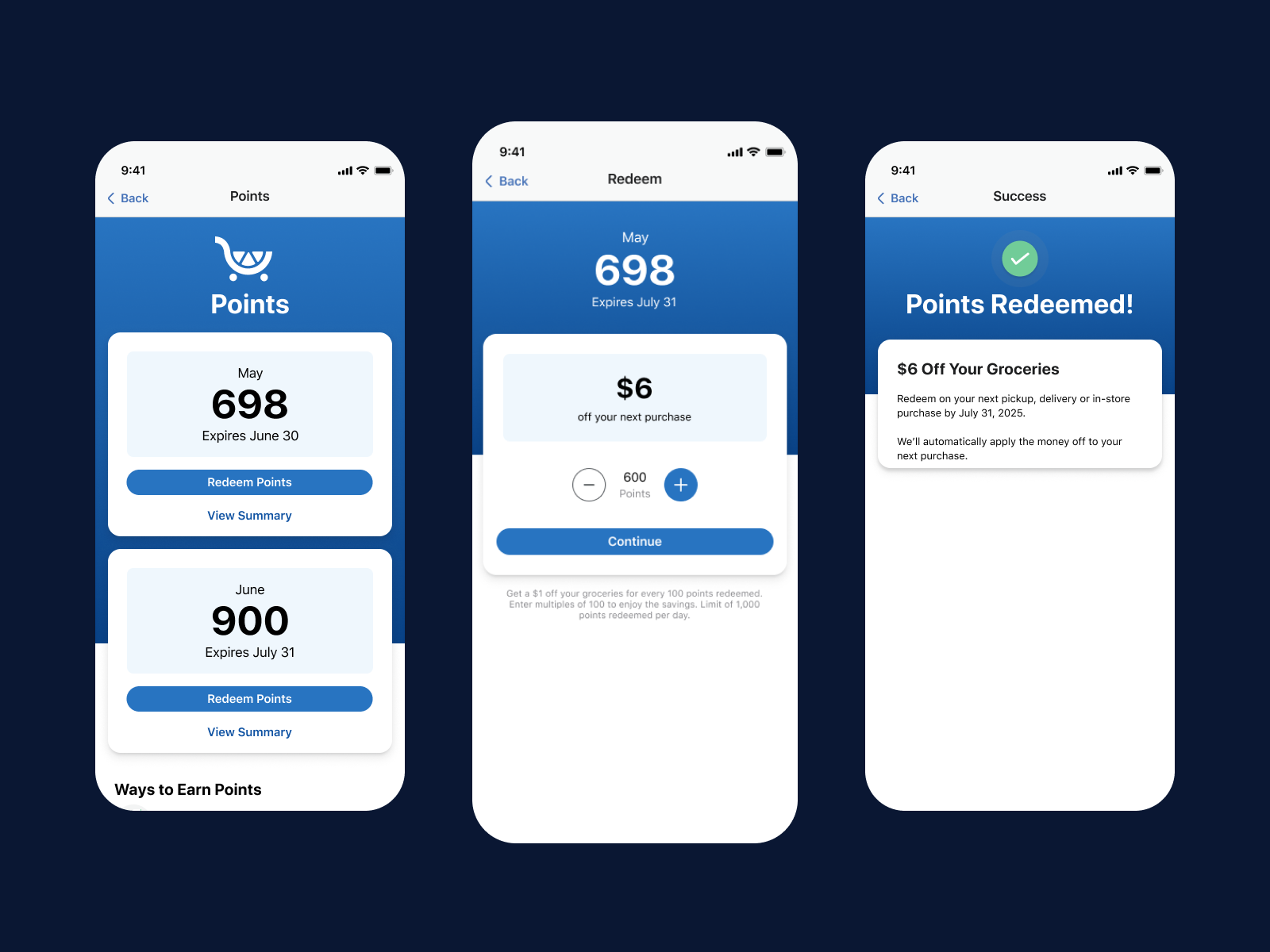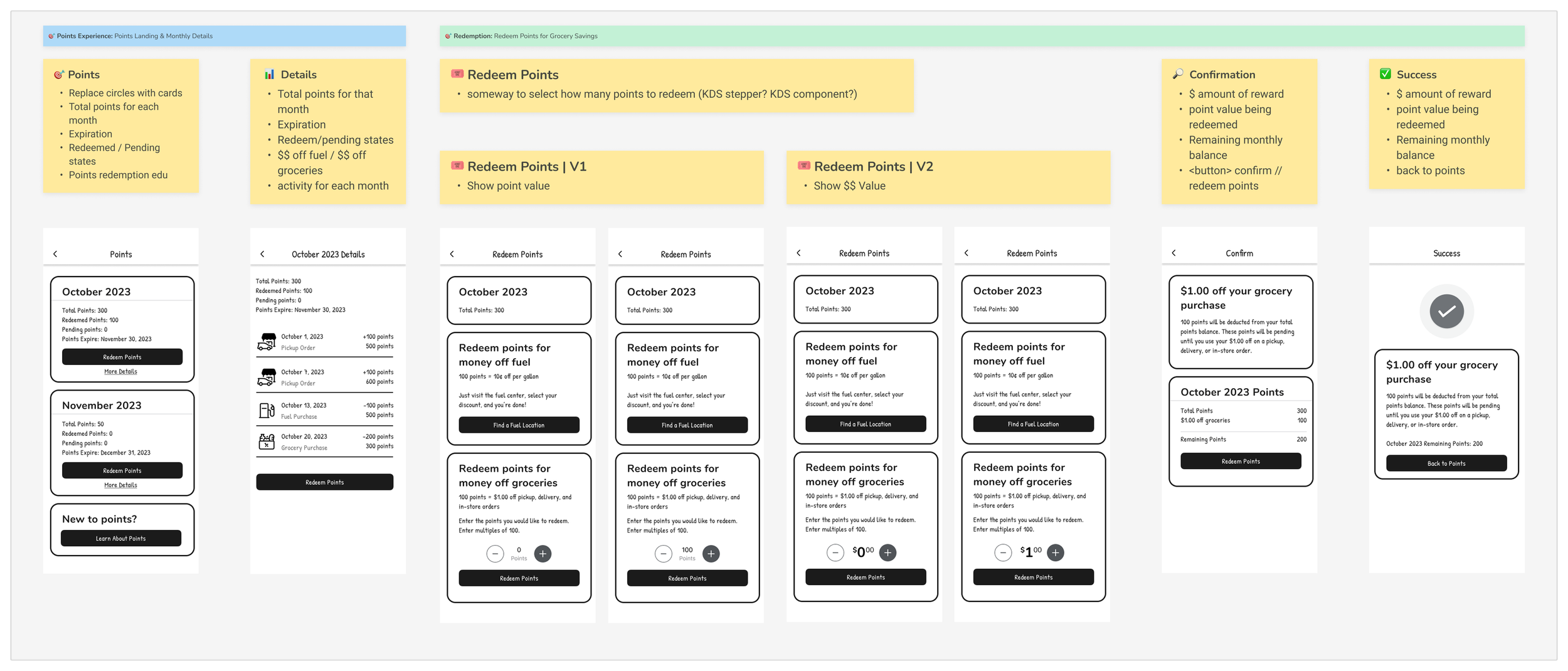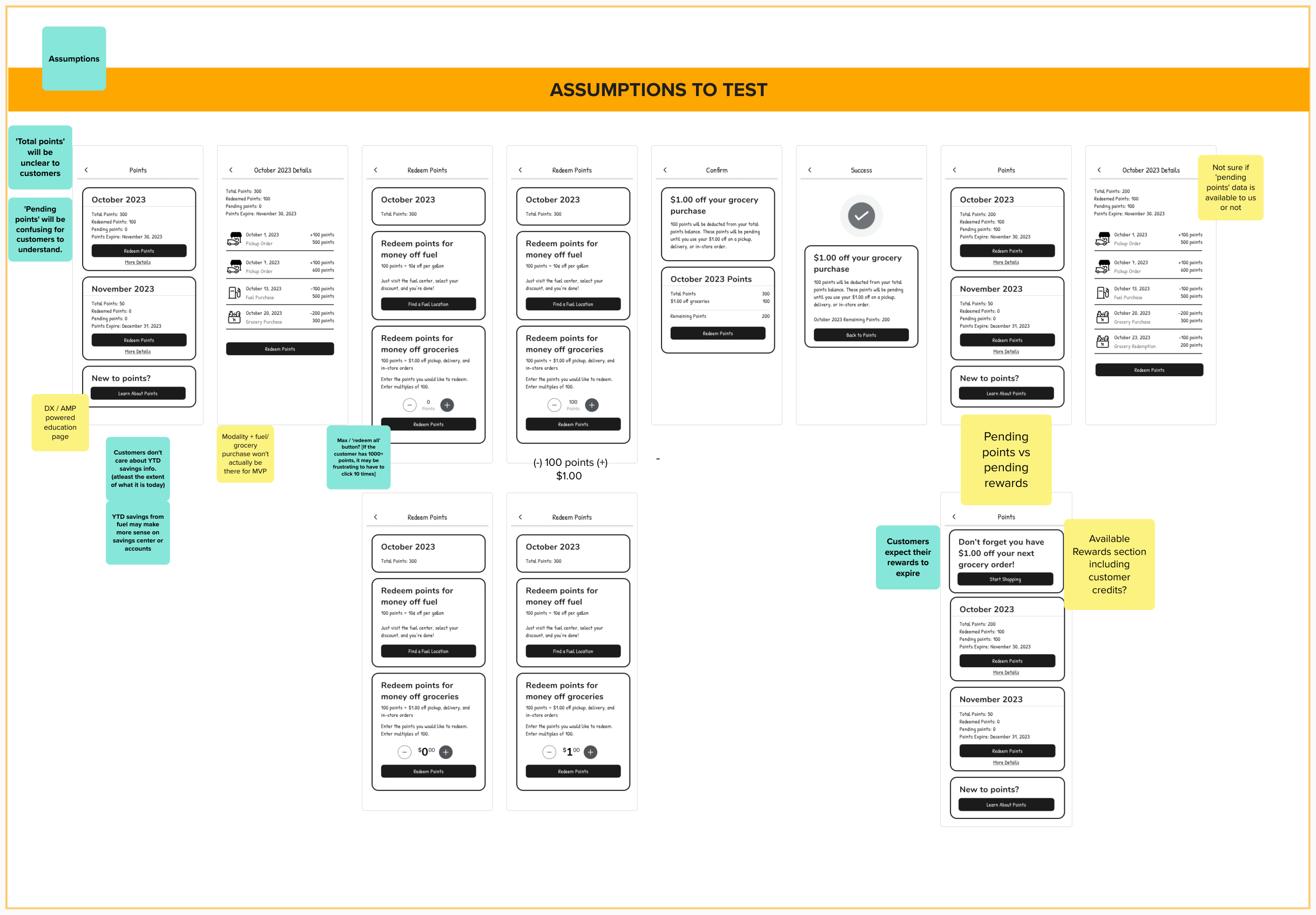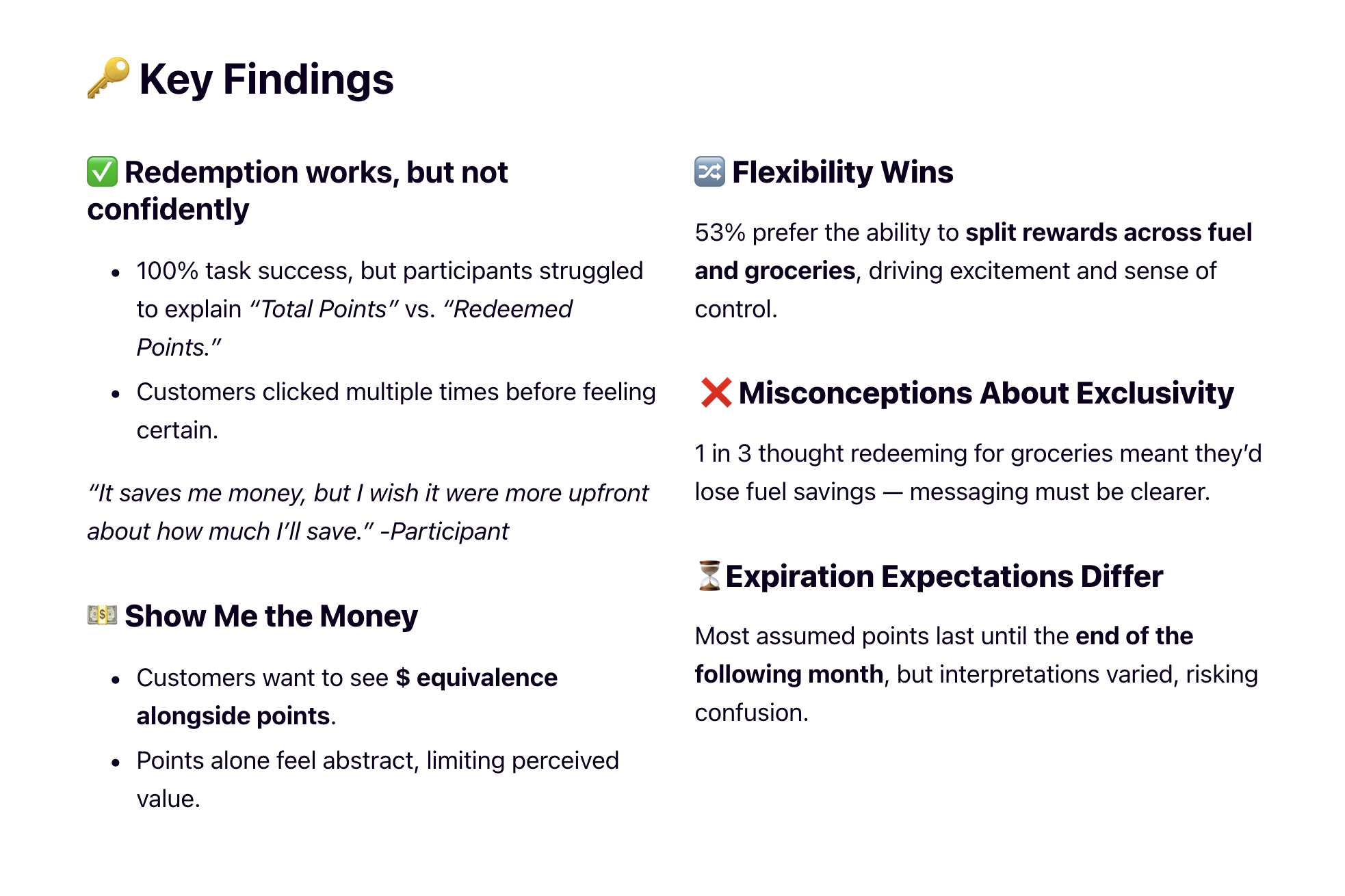Kroger Plus 2.0: Expanding Points Redemption Beyond Fuel
Transformed Kroger’s loyalty program from a fuel-focused perk into a broader grocery redemption system, driving adoption among non-drivers and creating measurable behavior change. This MVP proved the business case for flexible redemption and became a strategic lever for Kroger’s loyalty roadmap.
My Role: Lead Product Designer (Loyalty & Rewards)
Led end-to-end UX research, concept testing, and design for the redemption MVP.
THE PROBLEM
Fuel Points only worked at the pump → excluded non-drivers and left many households with unused rewards.
Loyalty expectations had shifted → shoppers expected flexible, instant, and personalized value (like credit cards + fast food perks).
Result: a disconnect between what the business offered and what customers actually valued.
THE SOLUTION
Launched Kroger Plus 2.0: expanded rewards to money off groceries, making loyalty relevant to all households.
Positioned point-to-cash redemption as a foundational step toward a flexible rewards model.
Designed flows, content, and redemption mechanics to be simple, instant, and repeatable.
Built infrastructure to scale to more categories and experiences.
THE IMPACT
🚀 50% conversion lift among Qualified Non-Redemeers (vs. 10% forecast).
📈 25% adoption among storeless households.
🔁 85% repeat redemption month-over-month.
Fuel Points as a Foundation
Kroger’s Fuel Points program launched in the late 1990s to reward shoppers with savings at the pump. Over time, it became a familiar part of the Kroger loyalty experience — especially for fuel-focused customers. Some shoppers even optimized their savings by purchasing gift cards during 4x Fuel Points events, stacking rewards with credit card perks and fuel discounts.This behavior underscored just how important Fuel Points were to a subset of customers — but it also revealed the program’s limits. Points were only useful if you drove, shopped a certain way, or lived near a participating station. As delivery became more common and electric vehicles gained traction, large segments of customers were left without meaningful ways to use their points.
This behavior underscored just how important Fuel Points were to a subset of customers — but it also revealed the program’s limits. Points were only useful if you drove, shopped a certain way, or lived near a participating station. As delivery became more common and electric vehicles gained traction, large segments of customers were left without meaningful ways to use their points.
Meanwhile, loyalty engagement remained high. 93% of sales were tied to Kroger Plus accounts, showing that customers were still willing to exchange their data and behaviors for value. But they weren’t seeing the full benefit. Over half of qualified households weren’t redeeming their points each month, even though 88% were aware of them.
Discovery (Before I Joined)
Unified Rewards Discovery (July 2022)
Loyalty Flexible Fuel Points Discovery
Discovery work for Unified Rewards had been underway for months before I joined the team. Earlier explorations defined both the problem space—fuel-only rewards excluded many high-value customers—and the opportunity—expand redemption into flexible models like groceries or cash back.
The Flexible Fuel Points discovery phase crystallized the MVP direction:
✅ Leverage the existing fuel points infrastructure
✅ Introduce grocery redemption for non-drivers and storeless markets (e.g., Philadelphia)
✅ Explore long-term flexibility: cash back, free items, gamification layers
SCREEN FLOW
Mapping the End-to-End Redemption Journey
When mapping the MVP flow, I expanded scope beyond the redemption steps to also capture where customers entered from. My hypothesis was that awareness and ease of access would be as critical to adoption as the redemption flow itself. By documenting these pathways, we created the ability to track engagement at each entry point and later design enhancements that surface loyalty more consistently across the journey.
Redemption flow map with multiple starting paths leading into a simplified five-page points customer experience
WIREFRAMES
Defining What Each Screen Needed to Deliver
I broke the points and redemption experience into five core screens and mapped what each needed to deliver. Capturing requirements as stickies turned assumptions into testable hypotheses and gave the team a shared framework that aligned design, product, and engineering. This approach balanced speed with rigor, allowing us to deliver a minimal, usable MVP while laying the foundation for scalable loyalty enhancements.
Redemption flow map with multiple starting paths leading into a simplified five-page points customer experience
USER FEEDBACK
Turning Discovery Assumptions Into a Research Plan
I worked with the discovery team to map our assumptions directly onto wireframes, capturing questions about terminology, value clarity, and expiration. These annotations became the foundation for a structured usability plan, aligning the team on what to test and why.
Wireframes annotated with sticky-note assumptions to guide testing
Structuring Assumptions Into a Test Plan
These assumptions were translated into a formal usability plan. Tasks and survey questions were designed to evaluate comprehension, redemption confidence, and mental models around expiration. By grounding the test plan in explicit hypotheses, we ensured feedback could be tied directly back to design decisions.
Structured usability test plan built from annotated assumptions
What We Learned
While all participants completed redemption tasks, confidence was low. Customers asked for dollar equivalence alongside points, clearer expiration rules, and reassurance that grocery redemptions didn’t cancel out fuel savings. These findings shaped the next round of design iterations.
Screenshot from one-pager created in Dovetail (View One Pager →)
Iteration & Testing
Evolving the Rewards Experience
Through iteration and testing, we simplified the experience by surfacing balance, expiration, and redemption up front with an entry points into the monthly summary to access the additional information on their points balance and activity. We also used this space to highlight Boost’s 2X Fuel Points — reinforcing value for members and creating a clear upsell path for non-members.
Progression from wireframes to iteration to final UI
Testing Balance-First Concepts
These assumptions were translated into a formal usability plan. Tasks and survey questions were designed to evaluate comprehension, redemption confidence, and mental models around expiration. By grounding the test plan in explicit hypotheses, we ensured feedback could be tied directly back to design decisions.
Screenshot from one-pager created in Dovetail (View One Pager →)










